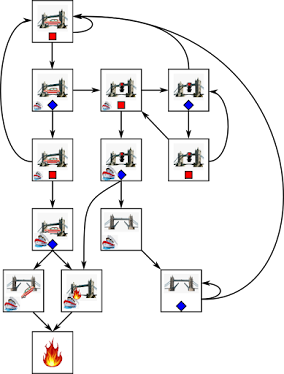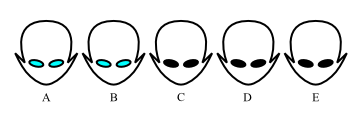On fiction: Rendezvous with NECA: the setting
Having looked a bit over the inspirations (I'll return on them a bit later when discussing characters), I'll now log the basic setting of Rendezvous with NECA. This, of course, is not how things will show up in the story. Specifically, I'll not use a chronologic order for the back story. That will hinted at, later; the start itself is when the action is about to start.
Sometime in the mid 2010s, maybe even tomorrow, a telescope photographs a previously unknown object in the distant reaches of the solar system. Somewhere beyond Saturn. More measurements help astronomers figure out its orbit. It is almost parabolic, with eccentricity slightly above 1. Meaning, it will get close to the Sun, then move away forever, like certain non-periodic comets. Also, and very peculiar, its orbital plane matches Earth's plane. There's no reason why a random extrasolar object would do that however.
Unlike non-periodic comets, it is quite large. And wheel-with-long-hub shaped. Therefore, the object is obviously artificial. All of this, along with object mass and temperature, would be measured by astronomers up until the mid 2010s in the world of this fictional history. The shape is a giveaway clue that it is not a comet, not an asteroid, not natural. It's obviously a ship. However, it's silent and cold. So it's also seemingly dead.
So humanity spots what is almost certainly a dead alien craft, which will pass somewhat close to Earth at one point. What to do? The decision is to send a team of astronauts to investigate it, of course, or I'd have no story. As to why that decision ...
Ostensibly, science. The object will get out of the solar system and be forever lost. Surely investigating it is the greatest scientific exploration ever, one group would say. Especially, as another group would add, it can yield practical things like alien tech.
And there's another reason: what if the object is not dead? Because of various things about orbital mechanics, it's very efficient to do a rocket burn when close to a massive body. Like the Sun, say. And while the object seems cold and dead, maybe it's just waiting to get to the Sun, and do a rocket burn to accelerate its departure ... or, the opposite, slow it down and put it on a transfer orbit to Earth. The exploring astronauts are therefore also, in essence, advance scouts. They are to figure what the object is about, before it parks itself at Earth. If that's what it wants to do.
There's therefore a hard limit on when the mission can happen. In particular, I've done some calculations about how the object's orbit might look like, how long it would take for it to get to one point or another, so that I can place its perihelion sometime mid to late 2020s.
Perihelion is important. The astronauts are to arrive at the object two weeks before perihelion and begin their explorations. With the help of the good folks at Orbiter Forum, I did some quick approximations to see how strong a rocket needs to be to pull that kind of mission off. It's not as bad as I feared. Could we do it today? No. Could we do it if we knew we had 10 years to work with, and we absolutely must get to that object two weeks before it reaches perihelion?
Well, for story purposes, the answer is yes. Various space programs in the world join forces. Several rich people and corporations do as well. The final ship is littered with ads and logos as a result.
I gave some thought to the human ship too. It would need a kind of nuclear propulsion (So you wanna build a rocket to the rescue), and I'm handwaving that suspended animation is available. Indeed, right now I'd guess the nuclear propulsion I've set my eyes on is easier to get to, more plausible, than suspended animation. Certainly easier to get by 2025. But anyway. The suspended animation tech is useful to make a multi-month mission possible. Keeping seven humans alive at full metabolic rate for a year in space is very resource intensive. Psychological issues also become important. Suspended animation is a convenient device to allow me to focus on other things. My astronauts begin their adventure fresh, and not with two months worth of cabin fever.
I did mention there are several reasons behind the expedition. I'm toying with the notion that not everyone of the astronauts think they are there for the same mission objectives. I'm also toying with the idea that since several countries put a lot of work into getting the mission done, they'd have agents on board to make sure the alien tech isn't split in a disadvantageous manner.
So there's enough potential for simmering conflict and human mystery, without needing to impair my astronauts with a long space journey for which they were awake.
Oh, there's a question. Why astronauts? Couldn't we have sent probes? My guess is that by the mid 2020s we'll still not quite have very agile robotics, certainly not for long distance cosmic use. Humans are sent to the object because humans are smart and adaptable. That's all there is to it. It could be one of the last hurrahs for manned space exploration. I could milk that for some thematic mileage if the story wants it.
Sometime in the mid 2010s, maybe even tomorrow, a telescope photographs a previously unknown object in the distant reaches of the solar system. Somewhere beyond Saturn. More measurements help astronomers figure out its orbit. It is almost parabolic, with eccentricity slightly above 1. Meaning, it will get close to the Sun, then move away forever, like certain non-periodic comets. Also, and very peculiar, its orbital plane matches Earth's plane. There's no reason why a random extrasolar object would do that however.
Unlike non-periodic comets, it is quite large. And wheel-with-long-hub shaped. Therefore, the object is obviously artificial. All of this, along with object mass and temperature, would be measured by astronomers up until the mid 2010s in the world of this fictional history. The shape is a giveaway clue that it is not a comet, not an asteroid, not natural. It's obviously a ship. However, it's silent and cold. So it's also seemingly dead.
So humanity spots what is almost certainly a dead alien craft, which will pass somewhat close to Earth at one point. What to do? The decision is to send a team of astronauts to investigate it, of course, or I'd have no story. As to why that decision ...
Ostensibly, science. The object will get out of the solar system and be forever lost. Surely investigating it is the greatest scientific exploration ever, one group would say. Especially, as another group would add, it can yield practical things like alien tech.
And there's another reason: what if the object is not dead? Because of various things about orbital mechanics, it's very efficient to do a rocket burn when close to a massive body. Like the Sun, say. And while the object seems cold and dead, maybe it's just waiting to get to the Sun, and do a rocket burn to accelerate its departure ... or, the opposite, slow it down and put it on a transfer orbit to Earth. The exploring astronauts are therefore also, in essence, advance scouts. They are to figure what the object is about, before it parks itself at Earth. If that's what it wants to do.
There's therefore a hard limit on when the mission can happen. In particular, I've done some calculations about how the object's orbit might look like, how long it would take for it to get to one point or another, so that I can place its perihelion sometime mid to late 2020s.
Perihelion is important. The astronauts are to arrive at the object two weeks before perihelion and begin their explorations. With the help of the good folks at Orbiter Forum, I did some quick approximations to see how strong a rocket needs to be to pull that kind of mission off. It's not as bad as I feared. Could we do it today? No. Could we do it if we knew we had 10 years to work with, and we absolutely must get to that object two weeks before it reaches perihelion?
Well, for story purposes, the answer is yes. Various space programs in the world join forces. Several rich people and corporations do as well. The final ship is littered with ads and logos as a result.
I gave some thought to the human ship too. It would need a kind of nuclear propulsion (So you wanna build a rocket to the rescue), and I'm handwaving that suspended animation is available. Indeed, right now I'd guess the nuclear propulsion I've set my eyes on is easier to get to, more plausible, than suspended animation. Certainly easier to get by 2025. But anyway. The suspended animation tech is useful to make a multi-month mission possible. Keeping seven humans alive at full metabolic rate for a year in space is very resource intensive. Psychological issues also become important. Suspended animation is a convenient device to allow me to focus on other things. My astronauts begin their adventure fresh, and not with two months worth of cabin fever.
I did mention there are several reasons behind the expedition. I'm toying with the notion that not everyone of the astronauts think they are there for the same mission objectives. I'm also toying with the idea that since several countries put a lot of work into getting the mission done, they'd have agents on board to make sure the alien tech isn't split in a disadvantageous manner.
So there's enough potential for simmering conflict and human mystery, without needing to impair my astronauts with a long space journey for which they were awake.
Oh, there's a question. Why astronauts? Couldn't we have sent probes? My guess is that by the mid 2020s we'll still not quite have very agile robotics, certainly not for long distance cosmic use. Humans are sent to the object because humans are smart and adaptable. That's all there is to it. It could be one of the last hurrahs for manned space exploration. I could milk that for some thematic mileage if the story wants it.


Comments
Post a Comment